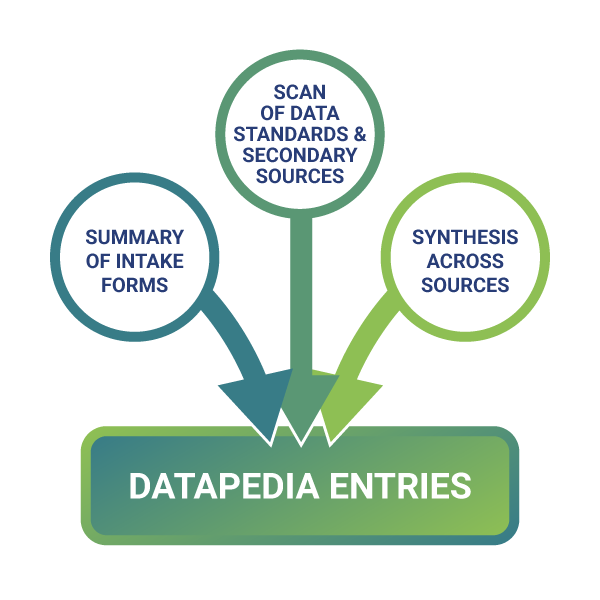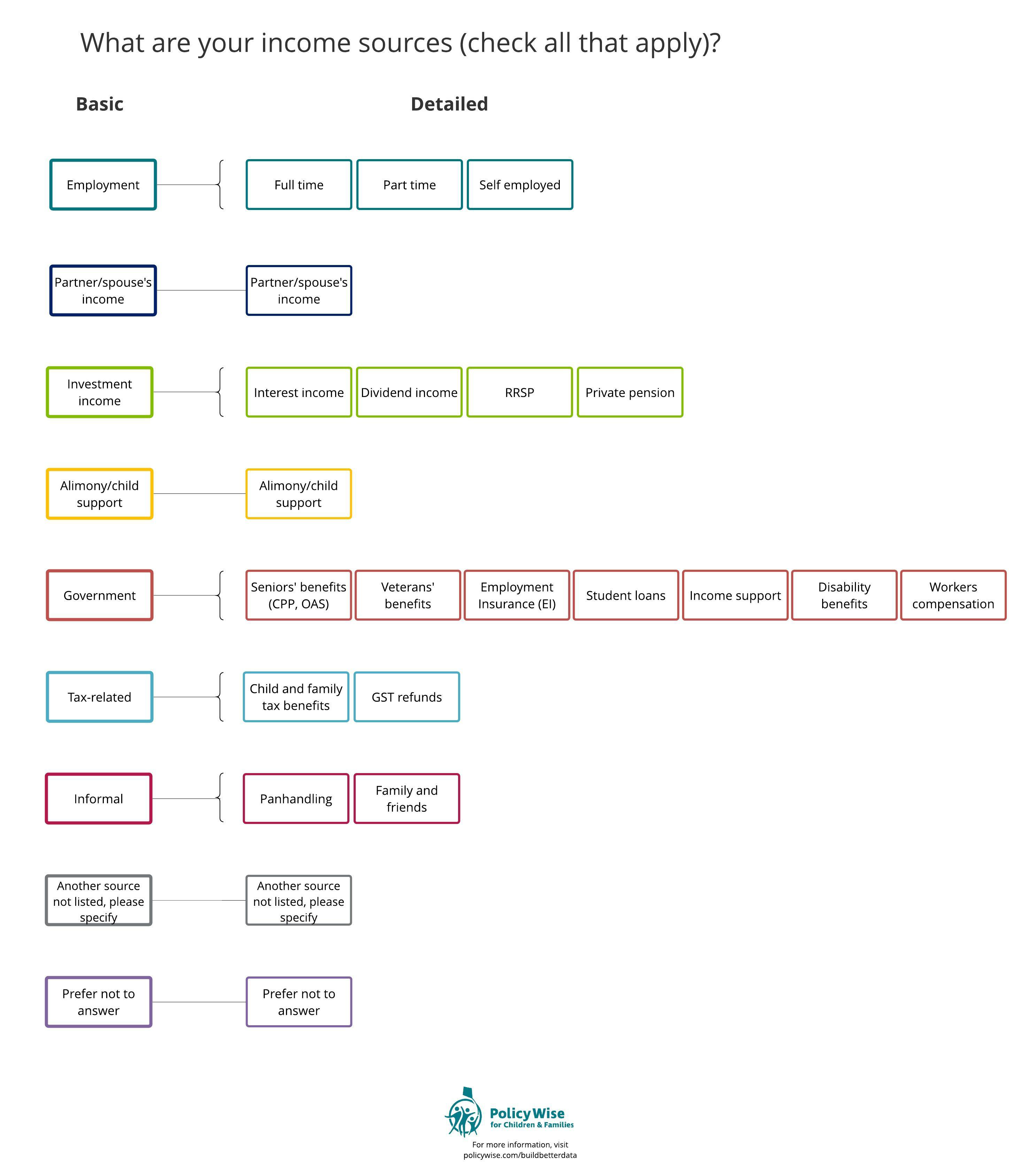Demographic Datapedia Entry:
Sources of Income
Each Datapedia entry begins with definition(s) of the demographic variable followed by some considerations and limitations of the variable for understanding populations of people.
Next, a suggested question(s) and response options are shown. Note that this is given as guidance rather than a prescription of what’s best as that will depend on the information needs and context of your organization. Also included are ideas and examples of how to ask questions about the demographic variable in conversation.

Plan
It’s important to invest time in seeking out your “Why?” with data to ensure the data collected support your information needs. For more on this, see the Plan section of the Data Lifecycle.
Finally, a diagram is shown to illustrate basic, detailed, and comprehensive response options for the variable.
- The basic options are the minimum set of response options that are suggested for each variable.
- The detailed and comprehensive categories illustrate more detailed and nuanced response options that may be important to consider depending on your information needs and organization’s context.
- The diagram of response options show how each category can be collapsed into the basic set of answers. For example, the detailed and comprehensive response options can be collapsed or aggregated into the basic response options for analysis.
- Consider all response options when deciding on which category best suits your organization’s needs.
Importantly, the suggestions and details of the response options will need to be revisited and revised periodically to reflect shifts and changes that may emerge in various variables over time.1

BUILD
For ideas on how to collect and record quality data see the Build section of the Data Lifecycle.
2.1 Definition
A. Income refers to the amount of money an individual receives from offering a service or from multiple sources.2, 3
2.2 Considerations and Limitations
Sources of income can be used to understand:
- Whether a client meets program eligibility.4, 5, 6
- Individuals can have more than one source of income.7
- In aggregate, knowing about the income of clients can demonstrate community needs in the services organizations provide.
Sources of income cannot be used to understand:
- The amount of income and whether the client’s income is adequate.8
- Details about household income as that can be important for example, for determining eligibility for programs for children and youth, or when an agency needs to consider household income and number of people in household, e.g., when calculating low-income cut-offs.9, 10
Additional Considerations:
- May be intrusive to ask about income without identifying a specific reason for asking.
- Asking for more details such as the amount of income in ranges, or overall household income, as this can be useful to better understanding needs or assessing whether a client meets certain eligibility criteria for programming.
2.3 Suggested Collection Methods
The minimum suggested data collection method, or “basic” option reflects a synthesis of practices, considerations from nonprofit stakeholders, and recognized standards in capturing demographic data. The suggested method is modeled after what might be asked on an intake form during an initial meeting with a client. The process by which intake or registration occurs can vary widely depending on the context within which you are working. For example, the way questions are asked and data are recorded will vary for clients in crises, as compared to walk-in or drop-in sessions, or when registering for a program that requires people to meet certain eligibility requirements. In those cases, the suggested collection method can be used as a starting point but adapted to fit the needs of the context within which the data are being collected.
As a standard practice we suggest always including an option for people to write in an answer that may not fit within the options provided, along with an option not to answer. These are both important for creating inclusive demographic questions.1, 11, 12
2.3.1 Basic Question(s)
1. What are your income sources
(check all that apply)?
- Employment
- Partner/spouse’s income
- Investment income
- Alimony/child support
- Government
- Tax-related
- Informal
- Another income source not listed: ____
- Prefer not to answer
In conversation, the question may be phrased as:
- Tell me about where your money is coming from.
- Are you getting money from more than one place?
2.3.2 Diagram of Response Options
The diagram shows an overview of the basic, detailed and comprehensive response options. The options are not necessarily exhaustive, but they are modeled after what organizations may want to provide depending on the needs and context of their work. The question can be found at the top of the diagram and the response choices are mapped into the basic, detailed, and comprehensive levels. Not all variables warrant all levels of response options.

COLLECT
For considerations on building trust and relationships through data collection see the Collect section of the Data Lifecycle.


LENSES
You may wish to approach your data collection work through the lens of a particular framework or set of guiding principles, which will shape how you think about your response options. For more details, see the Lenses section of the Data Lifecycle.
To create the diagram for variable responses, two main sets of sources were used.
- Organization intake and registration forms from nonprofit subsectors across Alberta.
- Best practices in data collection, academic literature of demographic data, and resources from data aggregators (e.g., Statistics Canada, National Institutes of Health).
Findings from these sources were synthesized and organized across three levels of response options: basic, detailed, and comprehensive. To learn more please see the full methods. Datapedia Project Approach and Acknowledgements.pdf
Footnotes
-
Frederick, J. K. (2020, November 18). Four strategies for crafting inclusive and effective demographic questions. Ithaka S+R Blog. https://sr.ithaka.org/blog/four-strategies-for-crafting-inclusive-and-effective-demographic-questions/
-
Statistics Canada. (2019, April 3). Total income of person. www23.statcan.gc.ca/imdb/p3Var.pl?Function=DEC&Id=100736
-
Government of Canada. (2021, January 28). Main groups of income. https://www.canada.ca/en/financial-consumer-agency/services/financial-toolkit/taxes/taxes-2/4.html
-
Government of Alberta. (2019, September 19). Eligibility criteria full-time learner. www.humanservices.alberta.ca/AWOnline/IS/5014.html
-
Government of Alberta. (n.d.). Income support – eligibility. www.alberta.ca/income-support-eligibility.aspx.
-
Government of Alberta. (2018, October 19). Student loans and grants eligibility assessment thresholds. www.canada.ca/en/employment-social-development/services/education/student-loan-eligibility-assessment.html
-
Statistics Canada. (2019, April 3). Total income of person. www23.statcan.gc.ca/imdb/p3Var.pl?Function=DEC&Id=100736
-
Keeley, B. (2015). What are income and wealth? Income Inequality: The Gap between Rich and Poor. OECD Publishing.
-
Statistics Canada. (2016, July 8). Low income lines: What they are and how they are created. https://www150.statcan.gc.ca/n1/pub/75f0002m/75f0002m2016002-eng.htm
-
Crossman, E. (2013, March). Low-income and immigration: An overview and future directions for research. https://www.canada.ca/en/immigration-refugees-citizenship/corporate/reports-statistics/research/low-income-immigration-overview-future-directions-research.html#s4
-
Fernandez, T., Godwin, A., Doyle, J., Verdin, D., Boone, H., Kirn, A., Benson, L., & Potvin, G., (2016). More Comprehensive and Inclusive Approaches to Demographic Data Collection. School of Engineering Education Graduate Student Series, 60. http://docs.lib.purdue.edu/enegs/60
-
Lesbian, Gay, Bisexual, & Transgender Equity Center. (n. d.). Good practices: Demographic data collection. University of Maryland. https://lgbt.umd.edu/good-practices-demographic-data-collection
Do you have additions to suggest to the Datapedia? Or, do you want to learn more about working with data?
We’d love to hear from you. Contact us at info@policywise.nickpetlock.com.


